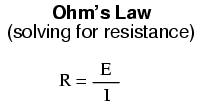Ohm's Law
PARTS AND MATERIALS
I'm purposely restricting the resistance
values between 1 kΩ and 100 kΩ for the sake of obtaining
accurate voltage and current readings with your meter. With
very low resistance values, the internal resistance of the
ammeter has a significant impact on measurement accuracy.
Very high resistance values can cause problems for voltage
measurement, the internal resistance of the voltmeter
substantially changing circuit resistance when it is
connected in parallel with a high-value resistor.
At the recommended resistance values, there
will still be a small amount of measurement error due to the
"impact" of the meter, but not enough to cause serious
disagreement with calculated values.
CROSS-REFERENCES
Lessons In Electric Circuits, Volume
1, chapter 2: "Ohm's Law"
LEARNING OBJECTIVES
-
Voltmeter use
-
Ammeter use
-
Ohmmeter use
-
Use of Ohm's Law
SCHEMATIC DIAGRAM

ILLUSTRATION

INSTRUCTIONS
Select a resistor from the assortment, and
measure its resistance with your multimeter set to the
appropriate resistance range. Be sure not to hold the
resistor terminals when measuring resistance, or else your
hand-to-hand body resistance will influence the measurement!
Record this resistance value for future use.
Build a one-battery, one-resistor circuit. A
terminal strip is shown in the illustration, but any form of
circuit construction is okay. Set your multimeter to the
appropriate voltage range and measure voltage across the
resistor as it is being powered by the battery. Record this
voltage value along with the resistance value previously
measured.
Set your multimeter to the highest current
range available. Break the circuit and connect the ammeter
within that break, so it becomes a part of the circuit, in
series with the battery and resistor. Select the best
current range: whichever one gives the strongest meter
indication without over-ranging the meter. If your
multimeter is autoranging, of course, you need not bother
with setting ranges. Record this current value along with
the resistance and voltage values previously recorded.
Taking the measured figures for voltage and
resistance, use the Ohm's Law equation to calculate circuit
current. Compare this calculated figure with the measured
figure for circuit current:

Taking the measured figures for voltage and
current, use the Ohm's Law equation to calculate circuit
resistance. Compare this calculated figure with the measured
figure for circuit resistance:

Finally, taking the measured figures for
resistance and current, use the Ohm's Law equation to
calculate circuit voltage. Compare this calculated figure
with the measured figure for circuit voltage:

There should be close agreement between all
measured and all calculated figures. Any differences in
respective quantities of voltage, current, or resistance are
most likely due to meter inaccuracies. These differences
should be rather small, no more than several percent. Some
meters, of course, are more accurate than others!
Substitute different resistors in the
circuit and re-take all resistance, voltage, and current
measurements. Re-calculate these figures and check for
agreement with the experimental data (measured quantities).
Also note the simple mathematical relationship between
changes in resistor value and changes in circuit current.
Voltage should remain approximately the same for any
resistor size inserted into the circuit, because it is the
nature of a battery to maintain voltage at a constant level.
|